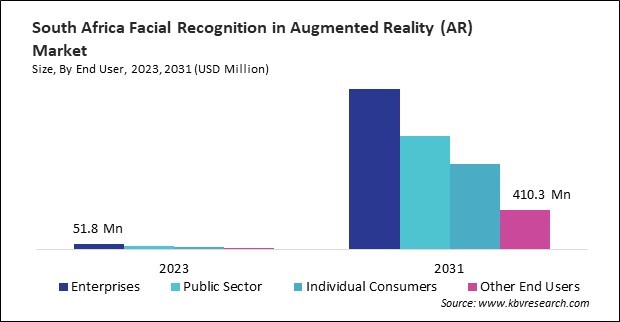The Latin America, Middle East and Africa Facial Recognition in Augmented Reality (AR) Market would witness market growth of 56.7% CAGR during the forecast period (2024-2031).
The Brazil market dominated the LAMEA Facial Recognition in Augmented Reality (AR) Market by Country in 2023, and would continue to be a dominant market till 2031; thereby, achieving a market value of $9,925.3 million by 2031. The Argentina market is capturing a CAGR of 57.9% during (2024 - 2031). Additionally, The UAE market would register a CAGR of 56.3% during (2024 - 2031).

With smartphones equipped with advanced cameras and processing capabilities becoming ubiquitous, businesses are leveraging facial recognition technology in AR applications that are easily accessible to a large user base. This has accelerated the adoption of AR experiences that utilize facial recognition. Social media platforms like Instagram and Snapchat have successfully integrated facial recognition with AR filters and effects. The popularity of these features encourages brands to adopt similar technologies to create engaging marketing campaigns and enhance customer interaction.
Innovation is at the forefront of the facial recognition and AR landscape, leading to several groundbreaking developments. Innovations in facial recognition now enable systems to detect a range of emotions in real time. By analyzing facial expressions, AR applications can tailor content dynamically based on the user’s emotional state, enhancing user engagement and interactivity.
As Brazil’s security sector expands, integrating facial recognition with AR can enhance private security services. Security companies can utilize AR solutions to improve operational efficiency, enabling security personnel to access vital information about individuals and situations in real time. Facial recognition technology can be employed in applications such as access control to ensure that authorized personnel are granted seamless entry while unauthorized individuals are denied access. By enhancing security protocols in various settings, including corporate offices, event venues, and public spaces, adopting these technologies can foster a safer environment for businesses and the public. Thus, the rising security sector in Brazil and the growing Smart City initiative in the UAE are poised to profoundly impact facial recognition technology's growth within the augmented reality industry.
Free Valuable Insights: The Worldwide Facial Recognition in Augmented Reality (AR) Market is Projected to reach USD 482.6 Billion by 2031, at a CAGR of 53.1%
Based on Technology, the market is segmented into 3D Facial Recognition, AI-Powered Facial Recognition, 2D Facial Recognition, and Other Technologies. Based on Device Type, the market is segmented into Smartphones & Tablets, AR Headsets & Glasses, Kiosks & Interactive Displays, and Other Device Types. Based on End User, the market is segmented into Enterprises, Public Sector, Individual Consumers, and Other End Users. Based on Industry Vertical, the market is segmented into Retail & E-commerce, Gaming & Entertainment, Healthcare, Security & Surveillance, Marketing & Advertising, and Other Industry Verticals. Based on countries, the market is segmented into Brazil, Argentina, UAE, Saudi Arabia, South Africa, Nigeria, and Rest of LAMEA.
By Technology
By Device Type
By End User
By Industry Vertical
By Country
Our team of dedicated experts can provide you with attractive expansion opportunities for your business.

